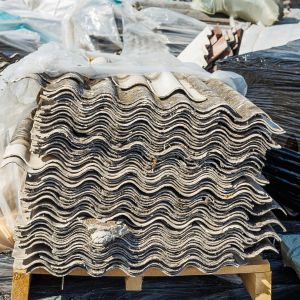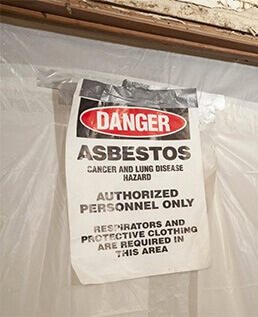Essential Tips for Understanding Asbestos Risks
Posted in Asbestos Removal, on December 07, 2023
Asbestos, once hailed for its utility, is now a recognized health hazard. In Ontario alone, asbestos-related illnesses continue to pose a significant threat, with a reported increase in cases over the past decade. The hazardous mineral is still found in many buildings and structures, so understanding the risks and taking proactive steps, including an asbestos inspection, asbestos removal in Toronto, and enlisting a trusted restoration company, is crucial for protecting your well-being. Starting with asbestos inspections and removal through to disposal, abatement must be approached with caution, skill, and expertise to safely mitigate the risks. Working with leading restoration specialists at an asbestos removal company near you like Canada’s Restoration Services can help you minimize risk and build a healthier space.
Why Concern Yourself with Asbestos?
 Asbestos, once lauded for its versatility and fire-resistant properties, is now recognized as a hazardous material that poses significant health risks. Asbestos exposure can lead to severe respiratory issues, including mesothelioma and lung cancer. In Toronto, understanding the importance of asbestos inspection, asbestos removal in Toronto, and partnering with a reputable restoration company is paramount in safeguarding your home, business, and loved ones.
Asbestos, once lauded for its versatility and fire-resistant properties, is now recognized as a hazardous material that poses significant health risks. Asbestos exposure can lead to severe respiratory issues, including mesothelioma and lung cancer. In Toronto, understanding the importance of asbestos inspection, asbestos removal in Toronto, and partnering with a reputable restoration company is paramount in safeguarding your home, business, and loved ones.
Understanding Asbestos Risks
Asbestos, commonly found in building materials before its ban in the late 20th century, still lurks in many homes and commercial buildings across Toronto. Its microscopic fibers, when disturbed, can become airborne, making inhalation highly probable during renovations, repairs, or even through deteriorating materials.
The potential harm of asbestos exposure cannot be overstated. According to recent data from the Ontario Ministry of Labour, Training and Skills Development, there has been a concerning rise in asbestos-related diseases, accounting for a substantial portion of occupational illnesses. These illnesses, including mesothelioma, lung cancer, and asbestosis, often develop years after exposure, underscoring the urgency for preventive measures.
Know What Illnesses Can Be Caused By Asbestos
Asbestos-related illnesses often manifest years after initial exposure, making early prevention and identification crucial. That's where asbestos inspection becomes essential.
The potential harm of asbestos exposure cannot be overstated. Asbestos-related illnesses like Mesothelioma and lung cancer often manifest years after initial exposure, making early prevention and identification crucial. That's where asbestos inspection becomes essential. At Canada’s Restoration Services, our specialists offer comprehensive asbestos inspections in the Greater Toronto Area. We use smart safety procedures and industry guidelines to assess the risk of an asbestos containing material and stop it from causing future problems.
Understand How Asbestos Can Cause Problems
Several factors influence the likelihood of asbestos exposure. Aging buildings, especially those constructed before the asbestos ban, pose higher risks due to potential deterioration of asbestos-containing materials. Renovations or repairs in such structures without prior asbestos inspections increase the chance of fiber release. Mitigating these risks involves prioritizing professional asbestos inspections before any renovations or demolition. Proper preparation and understanding of the building's history are crucial in identifying potential asbestos-containing materials. This proactive approach significantly reduces exposure risks. Its microscopic fibers, when disturbed, can become airborne, making inhalation highly probable during renovations, repairs, or even through deteriorating materials.
Learn Where You May Find Asbestos
Asbestos inspections serve as the initial defense against exposure risks. Professionals conduct thorough assessments, utilizing specialized equipment and techniques to identify ACMs.
Common Asbestos-Containing Materials Include:
- Insulation (Vermiculite): Vermiculite was used in attics and walls for insulation due to its heat-resistant properties. Vermiculite was mined in areas contaminated with asbestos which caused the harmful mineral to be found in households around Toronto and the country. In other cases, insulation contains asbestos for added heat resistance. Activity that may disturb: Renovation, insulation removal, or wall repair could potentially disturb asbestos-containing vermiculite, releasing harmful fibers into the air.
- Vinyl Floor Tiles: Vinyl floor tiles were commonly used as flooring material with asbestos to enhance their durability and affordability. Activity that may disturb: Removing or replacing vinyl floor tiles during renovation or remodeling could release asbestos fibers into the environment.
- Cement Sheets: Cement sheets were utilized in roofing and siding to provide structural integrity and weather resistance. Asbestos was often added to cement sheets for fire resistance and increased strength. Activity that may disturb: Activities such as roof repair, demolition, or siding replacement might disturb asbestos-containing cement sheets, potentially releasing hazardous fibers.
- Textured Paints/Coatings: Textured paints and coatings were used for decorative purposes and to create textured surfaces. Some older textured paints and coatings may contain asbestos fibers. Activity that may disturb: Sanding, scraping, or drilling into painted surfaces during renovation or maintenance could disturb asbestos-containing materials.
- Pipe Insulation: Pipe insulation was applied to pipes in heating systems to prevent heat loss using asbestos for its thermal insulation properties. Activity that may disturb: Repair or removal of pipe insulation during maintenance or renovations could release asbestos fibers into the surrounding environment.
- Popcorn Ceilings: Popcorn ceilings, also known as textured or acoustic ceilings, were popular for their sound-dampening and aesthetic qualities which were qualities facilitated by asbestos fibers which enhanced fire resistance and texture. Activity that may disturb: Scraping or sanding popcorn ceilings during renovation or repair work could release asbestos fibers into the air.
- Drywall: Drywall, commonly used for interior walls and ceilings, provides a smooth surface for painting and finishing. While asbestos was not typically part of the drywall itself, it was sometimes present in joint compound or mud used for seams and repairs. Activity that may disturb: Sanding, drilling, or cutting into walls containing asbestos-containing joint compounds may release asbestos fibers.
Understanding where asbestos might be found and the activities that could potentially disturb these materials is crucial to avoid accidental exposure. Professional inspections before any work involving these materials are essential to ensure safe handling and prevent the release of asbestos fibers.
Manage Risks and Maximize Safety with Asbestos Removal in Toronto
When it comes to effective asbestos abatement services in Toronto and throughout the Greater Toronto Area, it’s always important to consult the professionals. The team at Canada’s Restoration Services has more than a decade of industry experience. The most essential tip for avoiding harm from exposure is to schedule certified asbestos inspections in Toronto and avoid DIY removal efforts.







